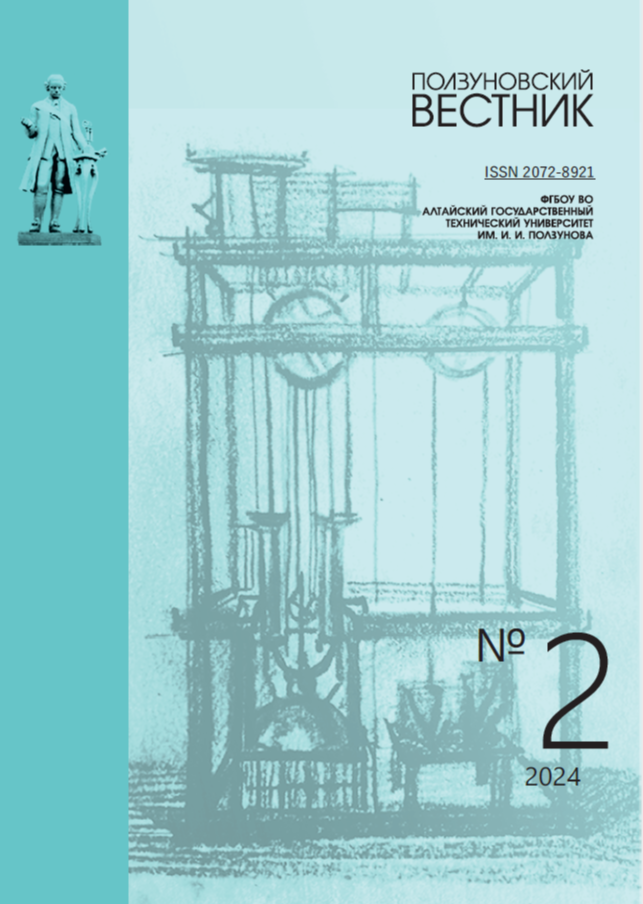MECHANISMS OF SECONDARY ULTRASONIC LIQUID SPRAY
ZXFXYU
DOI:
https://doi.org/10.25712/ASTU.2072-8921.2024.02.026Keywords:
spraying, aerosol, secondary spraying, minimum droplet size, dispersion, droplet destruction mechanism, cavitation, mathematical modelAbstract
Liquid atomization is the basis of various practical applications such as the production of pharmaceuticals, cosmetics, and food processing. In practice, it is often necessary to obtain an aerosol of high dispersion with sufficient productivity. However, creating an aerosol with maximum dispersion and high productivity is a difficult task. Some spray methods provide high dispersion but low throughput, while others provide sufficient throughput but generate large droplets. Secondary ultrasonic atomization can solve this problem by allowing non-contact atomization of droplets or jets using a powerful ultrasonic field. To do this, a stream of droplets or a stream of liquid previously generated in some way is directed into an ultrasonic emitter in the form of a hollow cylinder, in which an ultrasonic field is created. At a sufficiently high ultrasound intensity, conditions are realized for further fragmentation of droplets or destruction of liquid jets, and the output will be highly dispersed droplets. The productivity of such a process is limited only by the rate at which the liquid flow enters the secondary spraying device. This article discusses possible mechanisms of secondary ultrasonic atomization, proposes a mathematical model of this process, and finds patterns of the process depending on the defining parameters of the ultrasonic field and the physicochemical properties of the liquid. The following possible mechanisms for the destruction of jets and droplets have been proposed: direct destruction of droplets when they hit the front of an ultrasonic wave; cavitation mechanism of destruction of drops and jets. The dominant crushing mechanism depends on the parameters of the problem and, in turn, determines the minimum size of the resulting droplets. The free parameters of the model, which need to be determined experimentally, have been identified. The results of this work will help optimize the process of secondary ultrasonic atomization and improve liquid atomization technologies in various fields of application.
References
Application of Ultrasonic Atomization on a Micro Jet Engine Using Biofuel for Improving Performance / A. Alajmi [и др.]. // Processes. 2021. № 9. С. 1963. doi 10.3390/pr9111963
Recent advances in ultrasound-assisted synthesis of nano-emulsions and their industrial applications / P. Thakur [и др.]. // Current Pharmaceutical Biotechnology. 2021. № 22(13). С. 1748-1758. doi 10.2174/1389201021666201104150102
Y. Wang, L. Ruan Application of Ultrasonic Atomization in a Combined Circulation System of Spray Evaporative Cooling and Air Cooling for Electric Machine // Processes. 2021. №9(10). С. 1773. doi 10.3390/pr9101773
A review of physical and chemical methods to improve the performance of water for dust reduction / Q. Zhan [и др.]. // Process Safety and Environmental Protection. 2022. Т. 166. С. 86-98. doi 10.1016/j.psep.2022.07.065
Investigation on application of ultrasonic humidifier for air conditioning system / Putra I. [и др.] //Journal of Physics: Conference Series. – IOP Publishing. 2020. №. 1 (1450). С. 012050. doi 10.1088/1742-6596/1450/1/012050
A comprehensive review on ultrasonic spray pyrolysis technique: Mechanism, main parameters and applications in condensed matter / Ardekani S. R. [и др.] //Journal of Analytical and Applied Pyrolysis. 2019. Т. 141. С. 104631. doi 10.1016/j.jaap.2019.104631
K. C. Castro, J. M. Costa, M. G. N. Campos Drug-loaded polymeric nanoparticles: a review //International Journal of Polymeric Materials and Polymeric Biomaterials. 2022. №. 1(71). С. 1-13. doi 10.1080/00914037.2020.1798436
P. Majerič, R. Rudolf Advances in ultrasonic spray pyrolysis processing of noble metal nanoparticles // Materials. 2020. 13 №. 16(13). С. 3485. doi 10.3390/ma13163485
H. Naidu, O. Kahraman, H. Feng Novel applications of ultrasonic atomization in the manufacturing of fine chemicals, pharmaceuticals, and medical devices // Ultrasonics Sonochemistry. 2022. Т. 86. С. 105984. doi 10.1016/j.ultsonch.2022.105984
Ультразвук. Аппараты и технологии: монография / В.Н. Хмелев [и др.]. Бийск: Изд-во Алт. гос. техн. ун-та, 2015. 687 с.
Разработка высокочастотных ультразвуковых колебательных систем для мелкодисперсного распыления жидкостей / В. Н. Хмелев [и др.] // Ползуновский вестник. 2010. №. 3. С. 315-320.
Теоретическое выявление режимов воздействия, обеспечивающих формирование высокодисперсного аэрозоля при двухстадийном ультразвуковом распылении / Хмелёв В. Н. [и др.] // Ползуновский вестник. 2017. №. 2. С. 99-104.
В. Н. Хмелев, А. В. Шалунов, Р. Н. Голых, В. А. Нестеров Применение ультразвуковых колебаний для распыления жидкостей // Ультразвук: проблемы, разработки, перспективы: материалы международной научной конференции. Уфа: Башкирский государственный университет, 2017. С. 80–82.
Л. Д. Розенберг Физические основы ультразвуковой технологии. Москва: Наука, 1970. 688 с.
Ю. Я. Богуславский, О. К. Экнадиосянс О физическом механизме распыления жидкости акустическими колебаниями. Акустический Журнал. 1969. №. 1(15). C. 17.
А. А. Богач, А. В. Уткин Прочность воды при импульсном растяжении // Прикладная механика и техническая физика. 2000. №. 4(41). С. 198-205.
В. К. Кедринский Гидродинамика взрыва // Прикладная механика и техническая физика. 1987. №. 4 (28). С. 23-48.
The role of cavitation in submicron aerosol dispersion / Kudryashova O. [и др.] // MATEC Web of Conferences. – EDP Sciences. 2018. Т. 243. С. 00003. doi 10.1051/matecconf/201824300003
Downloads
Published
How to Cite
Issue
Section
License
Copyright (c) 2024 Olga B. Kudryashova, Andrey V. Shalunov, Sergey S. Titov, Roman S. Dorovskikh

This work is licensed under a Creative Commons Attribution 4.0 International License.















 .
. This work is licensed under a
This work is licensed under a 
